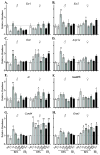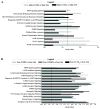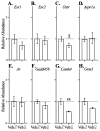Prenatal bisphenol A (BPA) exposure alters the transcriptome of the neonate rat amygdala in a sex-specific manner: a CLARITY-BPA consortium study
- PMID: 29097150
- PMCID: PMC5857226
- DOI: 10.1016/j.neuro.2017.10.005
Prenatal bisphenol A (BPA) exposure alters the transcriptome of the neonate rat amygdala in a sex-specific manner: a CLARITY-BPA consortium study
Abstract
Bisphenol A (BPA) is a widely recognized endocrine disruptor prevalent in many household items. Because experimental and epidemiological data suggest links between prenatal BPA exposure and altered affective behaviors in children, even at levels below the current US FDA No Observed Adverse Effect Level (NOAEL) of 5mg/kg body weight (bw)/day, there is concern that early life exposure may alter neurodevelopment. The current study was conducted as part of the CLARITY-BPA (Consortium Linking Academic and Regulatory Insights on BPA Toxicity) program and examined the full amygdalar transcriptome on postnatal day (PND) 1, with the hypothesis that prenatal BPA exposure would alter the expression of genes and pathways fundamental to sex-specific affective behaviors. NCTR Sprague-Dawley dams were gavaged from gestational day 6 until parturition with BPA (2.5, 25, 250, 2500, or 25000μg/kg bw/day), a reference estrogen (0.05 or 0.5μg ethinyl estradiol (EE2)/kg bw/day), or vehicle. PND 1 amygdalae were microdissected and gene expression was assessed with qRT-PCR (all exposure groups) and RNAseq (vehicle, 25 and 250μg BPA, and 0.5μg EE2 groups only). Our results demonstrate that that prenatal BPA exposure can disrupt the transcriptome of the neonate amygdala, at doses below the FDA NOAEL, in a sex-specific manner and indicate that the female amygdala may be more sensitive to BPA exposure during fetal development. We also provide additional evidence that developmental BPA exposure can interfere with estrogen, oxytocin, and vasopressin signaling pathways in the developing brain and alter signaling pathways critical for synaptic organization and transmission.
Keywords: Androgen; Brain; EDC; Endocrine disruptor; Estrogen; Oxytocin; Sex difference.
Copyright © 2017 Elsevier B.V. All rights reserved.
Conflict of interest statement
Figures




Similar articles
-
Effects of perinatal bisphenol A exposure on the volume of sexually-dimorphic nuclei of juvenile rats: A CLARITY-BPA consortium study.Neurotoxicology. 2017 Dec;63:33-42. doi: 10.1016/j.neuro.2017.09.002. Epub 2017 Sep 7. Neurotoxicology. 2017. PMID: 28890130 Free PMC article.
-
Perinatal bisphenol A (BPA) exposure alters brain oxytocin receptor (OTR) expression in a sex- and region- specific manner: A CLARITY-BPA consortium follow-up study.Neurotoxicology. 2019 Sep;74:139-148. doi: 10.1016/j.neuro.2019.06.007. Epub 2019 Jun 25. Neurotoxicology. 2019. PMID: 31251963 Free PMC article.
-
Impact of Low Dose Oral Exposure to Bisphenol A (BPA) on the Neonatal Rat Hypothalamic and Hippocampal Transcriptome: A CLARITY-BPA Consortium Study.Endocrinology. 2016 Oct;157(10):3856-3872. doi: 10.1210/en.2016-1339. Epub 2016 Aug 29. Endocrinology. 2016. PMID: 27571134 Free PMC article.
-
CLARITY-BPA academic laboratory studies identify consistent low-dose Bisphenol A effects on multiple organ systems.Basic Clin Pharmacol Toxicol. 2019 Aug;125 Suppl 3(Suppl 3):14-31. doi: 10.1111/bcpt.13125. Epub 2018 Oct 17. Basic Clin Pharmacol Toxicol. 2019. PMID: 30207065 Free PMC article. Review.
-
Flaws in design, execution and interpretation limit CLARITY-BPA's value for risk assessments of bisphenol A.Basic Clin Pharmacol Toxicol. 2019 Aug;125 Suppl 3:32-43. doi: 10.1111/bcpt.13195. Epub 2019 Feb 15. Basic Clin Pharmacol Toxicol. 2019. PMID: 30589220 Review.
Cited by
-
Impact of a bisphenol A, F, and S mixture and maternal care on the brain transcriptome of rat dams and pups.Neurotoxicology. 2022 Dec;93:22-36. doi: 10.1016/j.neuro.2022.08.014. Epub 2022 Aug 27. Neurotoxicology. 2022. PMID: 36041667 Free PMC article.
-
Impacts of Gestational FireMaster 550 Exposure on the Neonatal Cortex Are Sex Specific and Largely Attributable to the Organophosphate Esters.Neuroendocrinology. 2023;113(12):1262-1282. doi: 10.1159/000526959. Epub 2022 Sep 8. Neuroendocrinology. 2023. PMID: 36075192 Free PMC article.
-
Bisphenol A (BPA) induces progesterone receptor expression in an estrogen receptor α-dependent manner in perinatal brain.Neurotoxicol Teratol. 2020 Mar-Apr;78:106864. doi: 10.1016/j.ntt.2020.106864. Epub 2020 Jan 9. Neurotoxicol Teratol. 2020. PMID: 31926947 Free PMC article.
-
Gestational Exposure to Bisphenol A and Bisphenol S Leads to Fetal Skeletal Muscle Hypertrophy Independent of Sex.Toxicol Sci. 2019 Dec 1;172(2):292-302. doi: 10.1093/toxsci/kfz198. Toxicol Sci. 2019. PMID: 31501865 Free PMC article.
-
Placental PFAS concentrations are associated with perturbations of placental DNA methylation at loci with important roles on cardiometabolic health.medRxiv [Preprint]. 2024 May 7:2024.05.06.24306905. doi: 10.1101/2024.05.06.24306905. medRxiv. 2024. Update in: Environ Pollut. 2025 Jan 23:125737. doi: 10.1016/j.envpol.2025.125737. PMID: 38766233 Free PMC article. Updated. Preprint.
References
-
- Casas M, et al. Exposure to brominated flame retardants, perfluorinated compounds, phthalates and phenols in European birth cohorts: ENRIECO evaluation, first human biomonitoring results, and recommendations. Int J Hyg Environ Health. 2013;216(3):230–42. - PubMed
-
- Bushnik T, et al. Lead and bisphenol A concentrations in the Canadian population. Health Rep. 2010;21(3):7–18. - PubMed
-
- LaKind JS, Naiman DQ. Temporal trends in bisphenol A exposure in the United States from 2003–2012 and factors associated with BPA exposure: Spot samples and urine dilution complicate data interpretation. Environ Res. 2015;142:84–95. - PubMed
Publication types
MeSH terms
Substances
Grants and funding
LinkOut - more resources
Full Text Sources
Other Literature Sources

